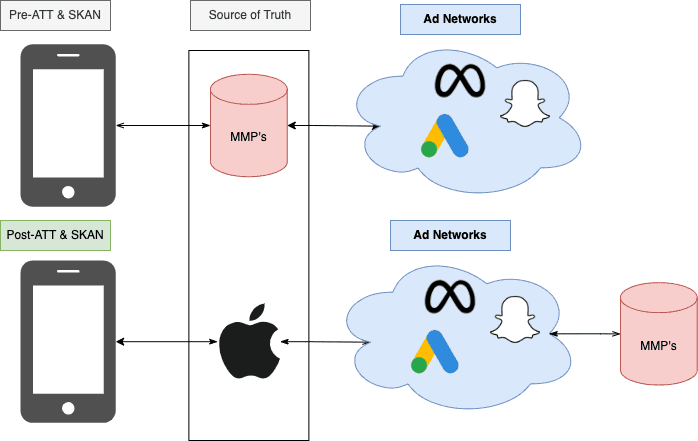Mobile apps and the internet are inherently different than each other despite mobile apps relying on the internet to provide much of their utility. The biggest difference between the two technologies is that the internet is an open protocol, while mobile apps are closed protocols governed by one corporation. Mobile operating systems (OS) run app stores with corporate guidelines and regulations over the types of mobile applications that can be installed on their systems. These walled gardens were originally created with the intent to protect their OS against applications running malicious code and illegal/controversial content, however, in cases like Apple’s, it has become an area of contention with anti-trust allegations and changes to user privacy disrupting the multi-billion-dollar mobile app advertising industry. The advertising disruption in particular has completely changed mobile app analytics and the value of mobile measurement partners (MMP’s), the primary platform businesses use for marketing attribution.
The release of Apple’s AppTrackingTransparency (ATT) framework uprooted data-sharing that allowed for precise ad targeting capabilities by networks and dented the ability for ad network algorithms to place ads with the right audiences. In addition to the impact on mobile advertising, it eliminated the ability to deterministically attribute installs and in-app conversions to an individual user, reducing the visibility into marketing performance for the advertiser. Now Apple’s SkAdNetwork (SKAN or SKAD) handles this attribution modeling in an aggregated and anonymized way. It only tracks if the ad network received credit or assisted in an install and if enough installs occur, the highest priority in-app conversion registered by the advertising app is triggered within a time-restricted window set by SKAN.
Apple’s attribution system is a far cry from the capabilities that MMP’s provide like log-level information and the ability to cohort in-app conversion events to the date a user installed the app by more than 100 days. Both features that help provide important and actionable insights to a business, and allowed MMP’s to own the mobile app analytics space. Since the release of SKAN they now must rely on Apple in order to report on any iOS marketing performance. Changing their value from marketing attribution provider to intermediary and eliminating one of the biggest value propositions of using an MMP which has brought up the question, how do MMP’s evolve from here?
One of their primary value adds to businesses since the SKAN change is their adoption of the SKAN SDK and the data mapping of its conversions. Rather than handling the technical burden of using the SKAN framework, businesses can rely on their MMP SDK to handle the ongoing updates and maintenance of the SDK and conversion tracking. In some cases, like that of Appsflyer, they have built on this by figuring out a white hat solution to bypass conversion limitations to track all conversion interactions rather than just the highest prioritized conversion that was triggered. Beyond this, they have partnerships with major publishers to make it easy to receive SKAN postbacks from publishers, decode the conversion value into a human-readable label and then map that value to the publisher event equivalent in a postback to publishers for use in bidding algorithms and reporting. Helpful tools, but not necessarily something that requires an MMP to implement. If business are willing to dedicate the development resources, they could replicate these tools. Not easy, but simpler than it ever has been to solve the iOS marketing attribution problem that MMP’s have capitalized on since the early 2010’s.
To counteract this change, many MMPs have stepped up their effort to enhance the SKAN reporting and clean up some yet to be resolved dirty data created by this attribution system. Features like improved organic vs paid reporting, a report that is not possible with SKAN alone, but by merging SKAN data with MMP tracked data and parsing SKAN from what MMPs capture. Certainly an important report to measure paid medias impact on a business, but is it enough to offset the damage that has already been done and justify the cost of an MMP?
The ball is still in Apple’s court at the end of the day and they control the destiny of iOS marketing attribution. While SKAN has significant pain points to be fixed, which helps the MMP’s case, the question remains, what happens when more development is made with SKAN to remove these issues and become a more robust attribution reporting platform? I still believe there is a ton of value that MMP’s provide today for both iOS and Android, but the sentiment has certainly changed around their importance with many businesses evaluating the value that MMP’s provide given their ability to go directly to Apple for reporting now. MMP’s feel the pressure to evolve and while they have developed stop-gap solutions, it is still unclear the steps they will need to take to retain their value as a universal mobile measurement solution.
